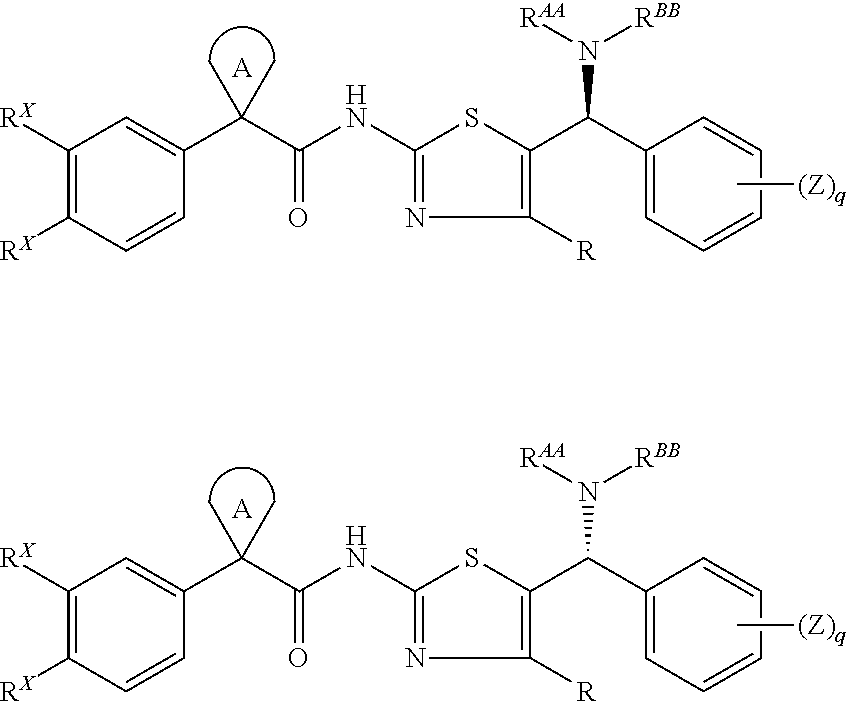Modulators of cystic fibrosis transmembrane conductance regulator
a technology of transmembrane conductance and cystic fibrosis, which is applied in the direction of drug compositions, extracellular fluid disorders, metabolic disorders, etc., can solve the problems of cystic fibrosis imbalance in ion and fluid transport, and individuals with two copies of the cystic fibrosis associated gene suffer from the debilitating and fatal effects of cystic fibrosis, etc., to achieve lessen the severity
- Summary
- Abstract
- Description
- Claims
- Application Information
AI Technical Summary
Benefits of technology
Problems solved by technology
Method used
Image
Examples
example 1
1-(Benzo[d][1,3]dioxol-6-yl)-N-(5-((R)-(2-chlorophenyl)((R)-3-hydroxypyrrolidin-1-yl)methyl)thiazol-2-yl)cyclopropanecarboxamide (2) hydrochloride and 1-(benzo[d][1,3]dioxol-6-yl)-N-(5-((S)-(2-chlorophenyl)((R)-3-hydroxypyrrolidin-1-yl)methyl)thiazol-2-yl)cyclopropanecarboxamide (1) hydrochloride
[0240]
1-Benzo[1,3]dioxol-5-yl-cyclopropanecarboxylic acid
[0241]
[0242]A mixture of benzo[1,3]dioxole-5-acetonitrile (5.10 g 31.7 mmol), 1-bromo-2-chloro-ethane (9.000 mL 108.6 mmol), and benzyltriethylammonium chloride (BTEAC, 0.181 g 0.795 mmol) was heated to 70° C. and then 50% (wt. / wt.) aqueous sodium hydroxide (26 mL) was slowly added. The reaction was stirred at 70° C. for 24 hours and then heated to reflux (130° C. bath temperature) for 72 hours. The dark brown / black reaction mixture was diluted with water (400 mL) and extracted twice with equal volumes ethyl acetate and dichloromethane. The basic aqueous solution was acidified with concentrated hydrochloric acid to pH less than one and...
example 2
(R)-1-((2-(1-(Benzo[d][1,3]dioxol-6-yl)cyclopropanecarboxamido)thiazol-5-yl)(2-chlorophenyl)methyl)pyrrolidin-3-yl (1S,2R,5S)-2-isopropyl-5-methylcyclohexyl carbonate
[0262]
[0263]1-(Benzo[d][1,3]dioxol-5-yl)-N-(5-((2-chlorophenyl)((R)-3-hydroxypyrrolidin-1-yl)methyl)thiazol-2-yl)cyclopropanecarboxamide (3.00 g, 6.02 mmol) was suspended in 200 mL of anhydrous dichloromethane containing N,N-dimethylpyridin-4-amine (2.20 g, 18.0 mmol). (1S,2R,5S)-2-Isopropyl-5-methylcyclohexyl chloroformate (1.91 mL, 9.00 mmol) was slowly added to the suspension and the resulting mixture was heated to reflux for 16 hours. The resulting pale yellow solution was allowed to cool to room temperature, diluted with 20 mL of methanol, and then evaporated to dryness. The crude reaction mixture was separated on 330 g of silica gel utilizing a gradient of 0-5% methanol in dichloromethane to yield the pure product as a pale yellow solid (2.0087 g, 2.9529 mmol, 49.1%). ESI-MS m / z calc. 679.3. found; 680.5 (M+1)+; R...
PUM
 Login to View More
Login to View More Abstract
Description
Claims
Application Information
 Login to View More
Login to View More - R&D
- Intellectual Property
- Life Sciences
- Materials
- Tech Scout
- Unparalleled Data Quality
- Higher Quality Content
- 60% Fewer Hallucinations
Browse by: Latest US Patents, China's latest patents, Technical Efficacy Thesaurus, Application Domain, Technology Topic, Popular Technical Reports.
© 2025 PatSnap. All rights reserved.Legal|Privacy policy|Modern Slavery Act Transparency Statement|Sitemap|About US| Contact US: help@patsnap.com



